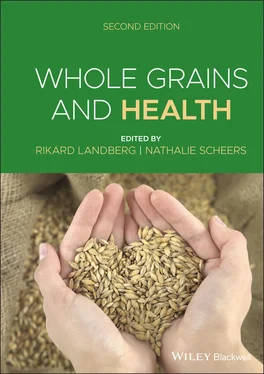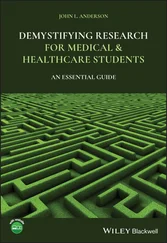Editorial Office The Atrium, Southern Gate, Chichester, West Sussex, PO19 8SQ, UK
For details of our global editorial offices, customer services, and more information about Wiley products visit us at www.wiley.com.
Wiley also publishes its books in a variety of electronic formats and by print‐on‐demand. Some content that appears in standard print versions of this book may not be available in other formats.
Limit of Liability/Disclaimer of Warranty The contents of this work are intended to further general scientific research, understanding, and discussion only and are not intended and should not be relied upon as recommending or promoting scientific method, diagnosis, or treatment by physicians for any particular patient. In view of ongoing research, equipment modifications, changes in governmental regulations, and the constant flow of information relating to the use of medicines, equipment, and devices, the reader is urged to review and evaluate the information provided in the package insert or instructions for each medicine, equipment, or device for, among other things, any changes in the instructions or indication of usage and for added warnings and precautions. While the publisher and authors have used their best efforts in preparing this work, they make no representations or warranties with respect to the accuracy or completeness of the contents of this work and specifically disclaim all warranties, including without limitation any implied warranties of merchantability or fitness for a particular purpose. No warranty may be created or extended by sales representatives, written sales materials or promotional statements for this work. The fact that an organization, website, or product is referred to in this work as a citation and/or potential source of further information does not mean that the publisher and authors endorse the information or services the organization, website, or product may provide or recommendations it may make. This work is sold with the understanding that the publisher is not engaged in rendering professional services. The advice and strategies contained herein may not be suitable for your situation. You should consult with a specialist where appropriate. Further, readers should be aware that websites listed in this work may have changed or disappeared between when this work was written and when it is read. Neither the publisher nor authors shall be liable for any loss of profit or any other commercial damages, including but not limited to special, incidental, consequential, or other damages.
Library of Congress Cataloging‐in‐Publication Data
Names: Landberg, Rikard, editor. | Scheers, Nathalie, editor.
Title: Whole grains and health / Rikard Landberg, Nathalie Scheers.
Description: Second edition. | Hoboken : Wiley, 2021. | Includes bibliographical references and index.
Identifiers: LCCN 2020024775 (print) | LCCN 2020024776 (ebook) | ISBN 9781118939437 (cloth) | ISBN 9781118939413 (adobe pdf) | ISBN 9781118939406 (epub)
Subjects: LCSH: Health. | Grain–Therapeutic use. | Grain in human nutrition.
Classification: LCC RA776 .W4556 2020 (print) | LCC RA776 (ebook) | DDC 613–dc23
LC record available at https://lccn.loc.gov/2020024775LC ebook record available at https://lccn.loc.gov/2020024776
Cover Design: Wiley
Cover Image: © Comaniciu Dan/Shutterstock
Cereal foods constitute a backbone of the diet worldwide and are the major source of energy and nutrients in many populations. The most common way cereal foods are consumed have detrimental effects on human health. The largest proportion of the intake consists of refined‐cereal products, generally associated with high glycemic index, reduced nutritional density and central in a dietary pattern associated with increased risk for non‐communicable diseases (NCDs). However, shifting the intake towards whole grains is associated with a consistently reduced risk of developing NCDs, specifically cardiovascular disease, type 2 diabetes and certain cancers. In fact, a high whole grain intake is listed as one of the most important modifiable risk factors of NCDs (Global Burden of Disease). Whole grain cereals are rich sources of fibre, many minerals, vitamins and phytochemicals. Public health authorities in the European Union, United States and around the world encourage the increased intake of whole grain cereals based on the health benefits, but recently also for improved sustainability. Most of the evidence for their beneficial effects stem from observational studies, while dietary interventions have shown acute effects on glucose, hormonal and inflammatory responses, and long‐term effects on insulin sensitivity, blood pressure and dyslipidaemia. Such effects have been linked to specific bioactive compounds, fibre components, gut microbiota, processing‐induced changes and the structural features of whole grains and cereal‐grain fractions. The dietary fibre complex, that is, dietary fibre and associated compounds, is believed to have a central role for the health effects of whole grain foods, but the mechanisms are to be elucidated in detail. The development of whole grain cereal foods has a potentially huge positive impact on the health of the global population, but there are important barriers to be torn down to succeed increasing the intake.
Since the first edition of the current book, the number of studies on whole grains and health have increased dramatically. In total, 2093 new publications on the search words whole grain AND health appeared in a Scopus search for the period 1 January 2007 to 26 March 2020. There has been a tremendous development of the field during the past decade, including definition and communication of whole grains to consumers, application of techniques to produce whole grain foods and studies of whole grain health effects. Such advancements are covered and discussed in detail in the different chapters of this book. For example, a large number of epidemiological studies have been carried out in different populations on the associations between whole grain consumption and risk of developing chronic diseases such as CVD, type 2 diabetes, some cancers, but also more rare diseases have been studied. Compared to older studies, more recent observational studies have investigated different grains separately and have also managed to estimate the intakes in g/d. Several large controlled human intervention studies have been conducted to investigate different aspects of whole grains on human health, including effects on cardiovascular and diabetes risk factors such as blood pressure, blood lipids, insulin sensitivity, body weight, body fat and inflammation. During the past decade, new biomarkers of whole grain wheat and rye intake has been developed and validated (alkylresorcinols and their metabolites). These biomarkers have been adopted and shown useful to assess compliance in whole grain intervention studies and they have successfully been used as an independent measure of whole grain intake in observational studies in humans. Metabolomics has emerged as a new approach to address health effects and to find new biomarkers of both dietary exposures and health effects related to whole grain intake. Several metabolomics studies have been published recently to achieve better understanding of health effects underlying whole grain consumption. Such studies have recently shown a modest effect on microbial composition after whole grain/high‐fibre cereal intake, which suggested several new mechanisms on why whole grain rye may have particular effects on insulin metabolism. Genomics have been applied in several large‐scale intervention studies and have provided new knowledge on how gene expression profiles cause changes in response to whole grain intake. This will be of importance for the overall understanding of the physiological responses in relation to whole grain intake. Moreover, new bioactive compounds in whole grains and whole grain fractions have been identified and are currently studied. One example of such is the group of benzoxazinoids, which have recently been identified in whole wheat and rye grains and in bakery products of these cereals. These compounds, isolated from other sources or synthesized, have been studied for a number of bioactivities. Their uptake and elimination in animals and humans as well as their effects are currently extensively studied. Untargeted metabolomics approaches have facilitated the process of discovering new compounds. The role of gut microbiota for human health and disease has boomed the last 10 years, and important insights on the role of whole grains and dietary fibre and their interaction with gut microbiota for differential responses in human health outcomes have increased dramatically, although there is still much to improve concerning our understanding in this area. EU‐regulations on health claims have been adopted with consequences for whole grain consumption. No health claim is allowed for whole grains but several specific claims, including grain components (reflecting beneficial physiological effects and disease risk reduction claims related to certain fibres) are allowed. No current worldwide definition of whole grain intake exists, but new definitions of both whole grains and whole grain products have been suggested.
Читать дальше












